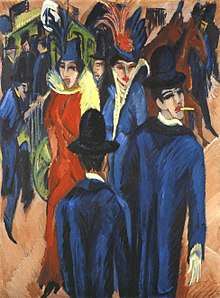Berlin Street Scene
Berlin Street Scene (German: Berliner Straßenszene) is a painting from the cycle Street scenes, by the German Expressionist artist Ernst Ludwig Kirchner. It was created in 1913 and belongs to this cicle of paintings, done until 1915. The cycle often depicts "Kokotten" (prostitutes) with their clients. The overall cycle is dubbed to be one of the most important works of German Expressionism.

Description
In the painting foreground, two Johns are depicted. One is facing the viewer, one is facing the prostitutes. The model for the Johns probably was the artist's friend, Otto Mueller, but it could be possible too that Kirchner depicted himself as the model. The models for the two prostitutes are the sisters Erna and Gerad Schilling.
The women are seen wearing very colourful clothing with elaborate lace collars and high-fashion hats. In the background one can see a busy street. On the street are a hackney carriage and the sign of the tram line 15, which at that time drove over the central stations of Berlin like Potsdamer Platz and the Brandenburg Gate. They are looking at the two men provocatively. The Johns reaction to this is giving them their attention or looking away. The style of capturing just a moment in the street life is emphasized through the cut off men.[1]
Style
In the painting influences of Italian Futurism can be found through the hasty dynamic of the work. The angular language of form is borrowed from Cubism.[2]
Interpretation
Kirchner often depicted prostitutes and their relationship to their Johns. This was not meant as social criticism but rather an attempt to depict his idea of a new independent type of woman.[2] Kirchner noted:
The street scenes developed in the years from 1911 to 1914. It was one of the loneliest times in my life, in which I wandered through the long streets full of people and wagons through day and night in agonizing unrest.
Causa Kirchner
In 2006 Anita Halpins, the granddaughter of the Jewish art collector Alfred Hess, demanded the restitution of the painting, which had previously been exhibited in the Brücke Museum in Berlin. The city granted the restitution. After that the painting was sold by the auction house Christie's for 30 million Euros to the art collectors Ronald Lauder and Serge Sabarsky. Then it became part of inventory of the Neue Galerie in New York. The restitution was based on the Washington Declaration from 1998 in which Germany said it would return the paintings that were confiscated during the Nazi era to the heirs of the victims.[3] The public reaction to the restitution was very negative. It was questioned whether the widow of Alfred Hess had been forced to sell the painting. Her family had gotten into financial troubles in 1929 after the world economic crisis and she could therefore have sold the painting for financial reasons. However the circumstances of the selling of the painting are unclear. The painting was transferred to the Cologne art association in 1936 and there sold to the art collector Carl Hagemann under unclear circumstances. Many people still questions whether the Washington Declaration was applicable in this case. It was doubted that the sale was connected to the persecution of Jews. Further more the Washington Declaration wasn't legally binding, therefore it wasn't necessary to restore the painting for legal reasons. Several complaints were filed against politicians from Berlin that had been involved in the restitution. The attorney's office however refused to file charges, which is why there were no convictions.[4] The sponsoring circle of the Brücke Museum still demands restitution of the painting back to them.[5]
References
- Galerie, Piper. Ernst Ludwig Kirchner - Großstadtbilder (in German). Kempten: R. Pipger & Co. Verlag München. p. 15. ISBN 978-3-492-02501-0.
- "Kirchners Berliner Straßenszene". Die Welt (in German). 4 May 2007. Retrieved 2016-10-01.
- Pressemitteilung der Senatsverwaltung für Wissenschaft, Forschung und Kultur, vom 17.
- Spiegel online 30.
- "Berliner Straßenszenen in New York" (in German). Frankfurter Rundschau. 2008-08-01. Retrieved 2016-10-01.